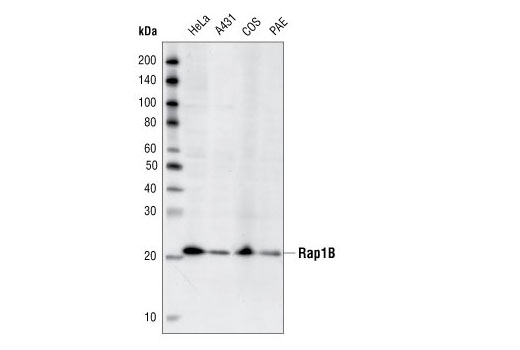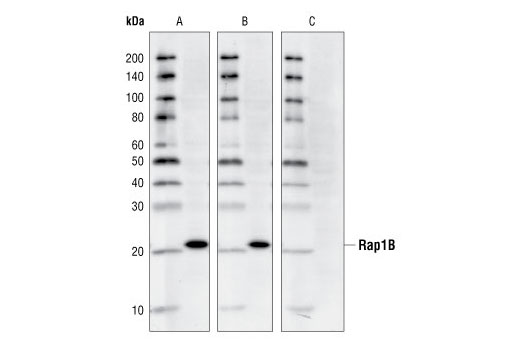WB
H M R Mk B Pg
Endogenous
21
Rabbit IgG
#P61224
5908
Product Information
Product Usage Information
| Application | Dilution |
|---|---|
| Western Blotting | 1:1000 |
Storage
Specificity / Sensitivity
Species Reactivity:
Human, Mouse, Rat, Monkey, Bovine, Pig
Source / Purification
Monoclonal antibody is produced by immunizing animals with synthetic peptides corresponding to the carboxy terminal half of human Rap1B.
Background
Rap1 and Rap2 belong to the Ras subfamily of small GTPases and are activated by a wide variety of stimuli through integrins, receptor tyrosine kinases (RTKs), G-protein coupled receptors (GPCR), death domain associated receptors (DD-R) and ion channels (1,2). Like other small GTPases, Rap activity is stimulated by guanine nucleotide exchange factors (GEF) and inactivated by GTPase activating proteins (GAP). A wide variety of Rap GEFs have been identified: C3G connects Rap1 with RTKs through adaptor proteins such as Crk, Epacs (or cAMP-GEFs) transmit signals from cAMP, and CD-GEFs (or CalDAG-GEFs) convey signals from either or both Ca2+ and DAG (1). Rap1 primarily regulates multiple integrin-dependent processes such as morphogenesis, cell-cell adhesion, hematopoiesis, leukocyte migration and tumor invasion (1,2). Rap1 may also regulate proliferation, differentiation and survival through downstream effectors including B-Raf, PI3K, RalGEF and phospholipases (PLCs) (1-4). Rap1 and Rap2 are not fuctionally redundant as they perform overlapping but distinct functions (5). Recent research indicates that Rap2 regulates Dsh subcellular localization and is required for Wnt signaling in early development (6).
- Bos, J. et al. (2001) Nat. Rev. Mol. Cell Biol. 2, 369-377.
- Caron, E. (2003) J. Cell Sci. 116, 435-440.
- Song, C. et al. (2002) Oncogene 21, 8105-8113.
- Rong, R. et al. (2003) J Biol Chem 278, 52497-503.
- Taira, K. et al. (2004) J. Biol. Chem. 279, 49488-49496.
- Choi, S. and Han, J. (2005) EMBO J. 24, 985-996.
Species Reactivity
Species reactivity is determined by testing in at least one approved application (e.g., western blot).
Western Blot Buffer
IMPORTANT: For western blots, incubate membrane with diluted primary antibody in 5% w/v BSA, 1X TBS, 0.1% Tween® 20 at 4°C with gentle shaking, overnight.
Applications Key
WB: Western Blotting
Cross-Reactivity Key
H: human M: mouse R: rat Hm: hamster Mk: monkey Vir: virus Mi: mink C: chicken Dm: D. melanogaster X: Xenopus Z: zebrafish B: bovine Dg: dog Pg: pig Sc: S. cerevisiae Ce: C. elegans Hr: horse GP: Guinea Pig Rab: rabbit All: all species expected
Trademarks and Patents
Limited Uses
Except as otherwise expressly agreed in a writing signed by a legally authorized representative of CST, the following terms apply to Products provided by CST, its affiliates or its distributors. Any Customer's terms and conditions that are in addition to, or different from, those contained herein, unless separately accepted in writing by a legally authorized representative of CST, are rejected and are of no force or effect.
Products are labeled with For Research Use Only or a similar labeling statement and have not been approved, cleared, or licensed by the FDA or other regulatory foreign or domestic entity, for any purpose. Customer shall not use any Product for any diagnostic or therapeutic purpose, or otherwise in any manner that conflicts with its labeling statement. Products sold or licensed by CST are provided for Customer as the end-user and solely for research and development uses. Any use of Product for diagnostic, prophylactic or therapeutic purposes, or any purchase of Product for resale (alone or as a component) or other commercial purpose, requires a separate license from CST. Customer shall (a) not sell, license, loan, donate or otherwise transfer or make available any Product to any third party, whether alone or in combination with other materials, or use the Products to manufacture any commercial products, (b) not copy, modify, reverse engineer, decompile, disassemble or otherwise attempt to discover the underlying structure or technology of the Products, or use the Products for the purpose of developing any products or services that would compete with CST products or services, (c) not alter or remove from the Products any trademarks, trade names, logos, patent or copyright notices or markings, (d) use the Products solely in accordance with CST Product Terms of Sale and any applicable documentation, and (e) comply with any license, terms of service or similar agreement with respect to any third party products or services used by Customer in connection with the Products.

